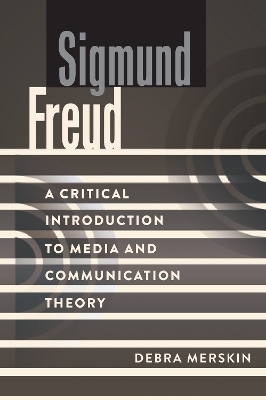
Sigmund Freud
A Critical Introduction to Media and Communication Theory
Seiten
2024
|
New edition
Peter Lang AG, Internationaler Verlag der Wissenschaften
978-3-0343-4993-2 (ISBN)
Peter Lang AG, Internationaler Verlag der Wissenschaften
978-3-0343-4993-2 (ISBN)
Provides an overview of Freud’s psychoanalytic theories and uses them as a lens through which to view media and popular culture. The book reviews how Freud’s theories have been applied to the study of film, advertising, news, and public relations, and discusses how scholars can use Freud’s ideas as tools to understand contemporary experiences.
Sigmund Freud’s theories and clinical practices focused primarily on individuals. As such, they are rarely considered when critiquing collective behavior or symbolic re-presentations. However, as the founder of depth psychology – a field of study that considers how unconscious components of the human experience influence psychological conditions – Freud understood the collective nature of thought and behavior. While his ideas are not typically a perspective applied to the study of media and popular culture, of audiences, or of content creation, once unpacked through a psychoanalytic lens, Freud’s theories shine a bright light on human motivation and expression.
This book is the first presentation of his ideas within this context. It is primarily an introduction to Freud and his theories intended for a communication studies audience. In addition to summarizing Freud’s major concepts, how/when/if they are taught in psychology programs, and the resultant "Freud Wars," this book offers examples of application of his ideas to cinema, advertising, public relations, and other forms of expression and recommendations for future research.
There are implications and applications to the everyday world as well for anyone interested in how theories of human development, beginning with childhood personality construction through adult sexuality, repression, and expression, can be understood through a contemporary lens.
"Of all of the contentious and oft-misconstrued figures in the history of ideas, few provide such a thorny and frustrating subject as Sigmund Freud. In this short-butsubstantial book, Deb Merskin gives us a considerate and approachable understanding of Freud’s work. She begins with a biographical sketch of Freud, builds on this foundation to outline the full spectrum of Freud’s theoretical interventions. With the basic rhythms and motifs established, Merskin then combines all of these elements to develop a symphonic sense of what Freud’s ideas can contribute to communication and media studies, with emphases on social theory, film theory, advertising, political communication, media psychology, and cultural studies. Here is a true introduction to Freud’s ideas as they relate to communication and media studies."
—David W. Park, Lake Forest College
Sigmund Freud’s theories and clinical practices focused primarily on individuals. As such, they are rarely considered when critiquing collective behavior or symbolic re-presentations. However, as the founder of depth psychology – a field of study that considers how unconscious components of the human experience influence psychological conditions – Freud understood the collective nature of thought and behavior. While his ideas are not typically a perspective applied to the study of media and popular culture, of audiences, or of content creation, once unpacked through a psychoanalytic lens, Freud’s theories shine a bright light on human motivation and expression.
This book is the first presentation of his ideas within this context. It is primarily an introduction to Freud and his theories intended for a communication studies audience. In addition to summarizing Freud’s major concepts, how/when/if they are taught in psychology programs, and the resultant "Freud Wars," this book offers examples of application of his ideas to cinema, advertising, public relations, and other forms of expression and recommendations for future research.
There are implications and applications to the everyday world as well for anyone interested in how theories of human development, beginning with childhood personality construction through adult sexuality, repression, and expression, can be understood through a contemporary lens.
"Of all of the contentious and oft-misconstrued figures in the history of ideas, few provide such a thorny and frustrating subject as Sigmund Freud. In this short-butsubstantial book, Deb Merskin gives us a considerate and approachable understanding of Freud’s work. She begins with a biographical sketch of Freud, builds on this foundation to outline the full spectrum of Freud’s theoretical interventions. With the basic rhythms and motifs established, Merskin then combines all of these elements to develop a symphonic sense of what Freud’s ideas can contribute to communication and media studies, with emphases on social theory, film theory, advertising, political communication, media psychology, and cultural studies. Here is a true introduction to Freud’s ideas as they relate to communication and media studies."
—David W. Park, Lake Forest College
Debra Merskin, PhD, is Professor Emerit in the School of Journalism & Communication at the University of Oregon. Her research focuses on the psychological process of stereotyping in media and popular culture in general and the impact on vulnerable populations in particular.
Preface – Who Was Sigmund Freud? – What Were Freud’s Main Theories? – How Have Freud’s Theories Been Used? – What Would a Study Look Like? – Freud in the 21st Century – Freud Timeline – Publications of Sigmund Freud – Index.
| Erscheinungsdatum | 05.04.2024 |
|---|---|
| Reihe/Serie | A Critical Introduction to Media and Communication Theory ; 13 |
| Mitarbeit |
Herausgeber (Serie): David W. Park |
| Zusatzinfo | 1 Illustrations |
| Verlagsort | Pieterlen |
| Sprache | englisch |
| Maße | 152 x 229 mm |
| Gewicht | 294 g |
| Themenwelt | Geisteswissenschaften ► Psychologie ► Psychoanalyse / Tiefenpsychologie |
| Sozialwissenschaften ► Kommunikation / Medien ► Kommunikationswissenschaft | |
| ISBN-10 | 3-0343-4993-9 / 3034349939 |
| ISBN-13 | 978-3-0343-4993-2 / 9783034349932 |
| Zustand | Neuware |
| Informationen gemäß Produktsicherheitsverordnung (GPSR) | |
| Haben Sie eine Frage zum Produkt? |
Mehr entdecken
aus dem Bereich
aus dem Bereich
Buch | Softcover (2022)
Kohlhammer (Verlag)
34,00 €
Grundlagen, Behandlungstechnik und Anwendung
Buch | Softcover (2022)
Kohlhammer (Verlag)
35,00 €


